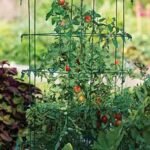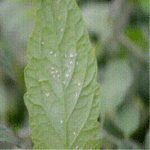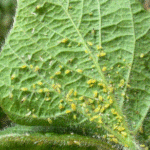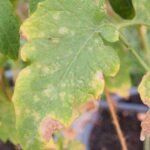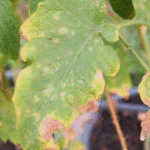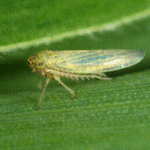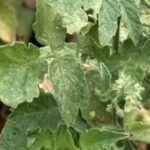Best Cultivation Tips for Tomato
Have you ever thought of eating your noodles or pizza without that tomato puree/sauce spread all over it ?
Or your Salad without it.
Never, Right !
Because it looks incomplete.
Tomato is one of the vital ingredients of the grocery store. In this article we will learn about it and its cultivation process.
General Description about Tomatoes
Tomato is an edible fruit/berry of the plant Solanum lycopersicum belonging to the nightshade family native to South America. It is consumed raw and even cooked in many dishes, sauces, salads and also in drinks. It is a fruit which is basically classified as berries and is commonly used as a vegetable ingredient or as a side dish.
Tomatoes are grown all throughout the year with the help of greenhouses and in numerous varieties in temperate climates. It grows upto 1 – 3 metres in height. They have a weak stem that sprawls and needs a proper support system. The size of the tomato varies according to the cultivation with a range of 1 to 10 cm in width.
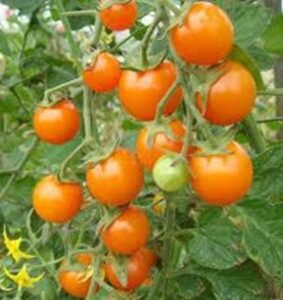
It has many nutritional purposes. It has a good source of vitamin C and phytochemical lycopene. It is labelled as a vegetable and is commonly eaten raw in salads or served as a cooked
vegetable, as an ingredient in many dishes or pickles. It is also packed as canned tomatoes, tomato juice,ketchup, puree, paste, or as dehydrated pulp.
Tomatoes are Red, White, Orange, Yellow, Brown and even Purple coloured depending on the variety and it forms several shapes including round, oxheart and oblong. They require enough sunlight as they grow in warm climates and are kept in hot houses during cooler climates.
Cultivation of Tomato
Tomatoes are particularly grown in every country of the world either in outdoor fields or in greenhouses or even in net houses.
According to FAO 2016, it occupies an area of about 4.73 million hectares with the production of 163.96 million tonnes in the world and contributes as the 3rd largest vegetable crop after potato and onion.
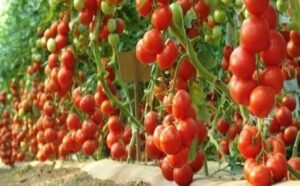
It is basically grown in summers but with the advent of greenhouse farming and many other farming techniques it is grown all throughout the year. It is the most widely cultivated crop in India and is a very important vegetable crop with respect to income and nutrition. It contains vitamin A and C with antioxidants in abundant quantities and due to these properties its demand is round the year.
Climatic Requirements
It is a warm season crop and the best ideal temperature for its cultivation is 20 to 25 degree Celsius and with intense heat like temperature above 43 degrees celsius, the plants could burn, even the flowers and small fruits would also fall. If the temperature goes below 13 degrees celsius or rises above 35 degree Celsius, it could harm the plant tissues and the crop production could decrease.
Tomato plants react differently to temperature variations during the growth cycle. This could be understood by the following table:
| Stages | Temperature (°C) | ||
| Min. temperature | Optimum Range | Max. temperature | |
| Seed Germination | 11 | 16-29 | 34 |
| Seedling growth | 18 | 21-24 | 32 |
| Fruit set | 18 | 20-24 | 30 |
| Red colour development | 10 | 20-24 | 30 |
Preparation of Land
Tomatoes grow well in deep, well drained soils with proper drainage ability. Although it can grow in every range of soils, Sandy loam or medium Black soils are considered to be the best for its cultivation and the soil pH must be 6 – 7.
The upper layer of the soil needs to be permeable with a depth of 15-20 cm for a healthy crop. Deep ploughing allows better root penetration in heavy clayey soils.
Growing Tomatoes in Raised Beds
Raised beds are built on a ground which is free of any type of weeds and is adequate for drainage. It is made 12 inches tall so as to give best results. It is filled with high quality soil which is slightly acidic, light, well draining, with humus and organic matter, and rich in nutrients.
Raised beds warms up the soil faster and so it is better to grow tomatoes in it as they love heat and grow better and faster in hot temperatures.
Best type of seeds
There are particularly two distinct types of seeds:
- Determinate/Indeterminate
- Heirloom/Hybrid
Determinate tomatoes are determined to a fixed length.These tomatoes grow at the end of the shoots and are grown all at once and then stop growing. These plants are compact and require no pruning or staking. Some of them produce large fruits such that they don’t need any support.
Indeterminate tomatoes grow all throughout the summer season as the flowers grow along the vines rather than the ends. They grow indefinitely until stopped by the cold climate. They need support and pruning.
Heirloom tomatoes are developed by old-fashioned methods of growing tomatoes with seeds of desirable qualities. They pass through open pollination and if these seeds are grown in relative isolation from others, it’s breed is true.
Hybrid tomatoes are prepared through cross pollination of different varieties.
Choice of Seeds
The choice totally depends on the local conditions and the characteristics like type of fruit, shape, vitality and resistance to pests and diseases. Climate and management is another factor. These days farmers are likely in favour of hybrid seeds as it provides better yield as compared to other local varieties of tomatoes. The choice is made not only because of better yield but also on the basis of transportation. These tomatoes have a thick outer cover which is less perishable and which can withstand any weather for more than a week. There are many other factors also such as size, colour and weight of tomatoes that force them to prefer hybrid seeds.
Seed Rate of Tomatoes
Seed rate is divided into two areas of cultivation:
- Higher Region (1100 Metres above MSL)
| Seed Rate (Kg/Ha) or No. of plants/Ha | Spacing (cm)
Row x Plant |
| 0.5 or 26.000 to 27,000
0.2 or 17,000 to 17,500 |
60 × 60
90 × 60 |
- Lower Region(Above 1100 Metres M.S.L)
| Seed Rate (Kg/ha) or
No. of plants/Ha |
Spacing (cm) Row x Plant |
| 0.5 or 25.000 to 26.000
02 or 16.500 to 17,000 |
60 × 60
90 × 60 |
Seedlings
Tomatoes are well grown when their seedlings are prepared/raised in a nursery. There are two methods to grow the seedlings:
- sowing in seedbed
- sowing in seedling tray

Seeds are planted in smaller quantities and are checked for growth and health before planting.
Transplanting
When plants are replaced from one place to another, it is termed as Transplantation. It is done to improve the quality of growth as it is good for better penetration of roots in the soil. The seedlings are transplanted after 3 to 6 weeks of sowing. The seedlings should be 15-25 cm tall with 3-5 true leaves and before taking them out of the seedbed it is hardened by reducing the application of water but it should not damage the roots so it is watered again just before taking them out.
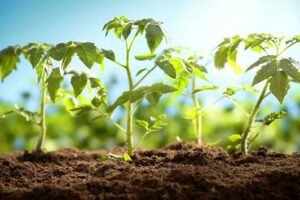
After Transplantation, water them and make sure that the roots are well attached to soil before removing the seedlings as it could damage them. The transplanted plants need to be protected from heat for the first five days.
Pruning
The process of cutting away the dead or overgrown branches or stems so as to promote healthy growing of plants is termed as Pruning. Pruning is important for tomatoes as it improves the light penetration and air circulation. Pruning of the side shoots are termed as Nipping and Pruning of the top stems as Heading. Pruning depends on the type, size and quality of fruit/plant. If they are not pruned, their growth will be limited.
Weed Control & Intercultural operations
Weeds are competitors with the crops for nutrients, moisture and sunlight so it needs to be adequately controlled. Some weeds are often home to pests and certain tomato diseases.
Weeds are mostly controlled by means of mechanical and/or hand cultivation using some herbicides such as pendimethalin @ 0.75kg/ha or oxyflorophen @ 0.12kg/ha.
Some herbicides like metribuzin @ 0.35 kg/ha and fluchloralin @ 1.25kg/ha are applied during the pre-emergence period, to increase the tomato yield significantly.
Plastic mulching is also done for weed control. PCPA spraying at 50ppm, IAA at 50.ppm or borax 1% at the flowering stage is favorable for the fruit set during high and low temperatures.
Staking of Tomatoes
The process of providing a support system to the growing media in the form of stakes or rod is called Staking.
Staking of tomatoes improves its growth and quality of fruits and also increases the fruit bearing capacity. It not only provides support to the plant but also provides easy access to collect it after harvesting, prune them and also monitor them for pests and any diseases.
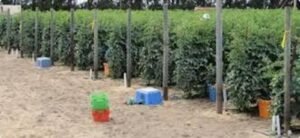
Staking decreases contact with soil and allows better airflow through the plants which improves the overall harvest.
Staking is done through various methods depending on the variety of plants. These are:
- Single stake method
- Tomato cages
- Vertical string method
- Weave method
- Trellis method
Fertigation of tomatoes
Fertigation is the combination of Fertilizer and Irrigation. Fertilizers are injected into Irrigation system which is used for soil amendments, water amendments and other water soluble products, popularly used by commercial growers to target the plant’s nutrient deficiency directly. It is the most effective approach rather than traditional fertilization.
Tomatoes require nutrient in two forms:
- Macronutrients such as Nitrogen, Phosphorus, and Potassium are required in large quantities as they are the most important nutrients required by the fertilizers.
- Micronutrients such as Calcium, Magnesium, Iron, Manganese, Boron, Carbon, Zinc, Sulphur, Molybdenum and Chlorine are required in small quantities as they are very essential for the growth and development of the plants.
Fertilizers are the carriers of these nutrients. They are of two types:
- Organic fertilizers which include farmyard manure, poultry manure and compost manure.
Farmyard manure are waste materials from farm animals. Poultry manure is the combination of faecal waste and urine. Compost manure is a rich source of natural fertilizer which comes from household or Municipal wastes of the environment.

- Inorganic or Synthetic fertilizers which provide either one nutrient (Single fertilizer) or more than one nutrient (compound fertilizer) like NPK 15:15:15, NPK 10:10:10, NPK 20:20:20.
The best way to fertilize tomatoes could be that which has both macronutrients & micronutrients. However, during each growth cycle the ratio of these nutrients required are different. Hence, you should have a proper understanding of your plant before cultivation.
| Days After | Total | Qty/Kg/Day/acre | |||||||
| Sowing | Days | ||||||||
| Urea | Ammonium | Calcium | (MoP) | MgSo4 | 13-0- | 19- | |||
| Sulphate | Nitrate | White | 45 | 19-19 | |||||
| 15-30 | 15 | 10 | 15 | ||||||
| 31-60 | 30 | 25 | 30 | 10 | 30 | 5 | 5 | 5 | |
| 61-90 | 30 | 25 | 40 | 10 | 30 | 10 | 10 | 10 | |
| 91-120 | 30 | 30 | 40 | 13 | 30 | 10 | 10 | 10 | |
| 121-150 | 30 | 13 | 25 | 5 | 5 | 5 | |||
| 103 | 150 | 33 | 90 | 30 | 30 | 30 | |||
| Rate | |||||||||
| Rs./Kg | 7.5 | 21 | 22 | 20 | 10 | 70 | 48 | ||
Irrigation Scheduling of Tomatoes
Irrigation scheduling is the planning about when, how, how much and how often you need to irrigate/water your plants.
The most effective way of irrigation is Drip irrigation which maintains soil moisture. Water is directly applied to the surface of the soil or below the soil surface in the crop row due to which evaporation reduces as compared to Overhead irrigation where water evaporates before it reaches the crop canopy and it also loses from the plant and soil surfaces.
Irrigating too much will result in run-off or loss of water below the root zone. Excess water can also damage the crops and loss of soil nutrients too and can increase soil erosion.
Pests & Disease Management
Some of the diseases of tomato and their control are:
- Speck and Spot – It is spread by water and can be controlled if the water could be dried and the environment could be made warm.
- Early Blight – It is also spread by water and germinates on moist leaves. It can be controlled by preventing water collection on leaves and always cut off the dead and infected plant materials.
- Late Blight – It grows quickly on leaves and stems and can be spread to other tomatoes, peppers, or potatoes as well. To control this, you should avoid sprinkler irrigation and try to keep the humidity low. Always clean the debris at the end of season.
- Verticillium Wilt – It enters through roots and spreads upto stems and leaves. For protecting crops from this you should manually sterilize the land and often use insecticides.
- Powdery Mildew – It doesn’t cause much damage but only brown dead patches which can be controlled by Sulphur dust.
- Cutworms – These are caterpillars who eat young plants in the soil and can even harm the seedling completely. You can prevent them by eliminating weeds around garden beds and by protecting the seedlings with cardboard collars or toothpicks.
- APHIDS – It affects the vigorously growing plants and can be controlled by simply crushing them with hands or splashing water.
- Stinkbugs – These are corky white patches under the skin of ripe tomatoes. You can handpick them or snip them to prevent it. Also eliminate weeds around garden beds.
- Snails and Slugs – They eat the tomatoes if they’re placed in or near the ground. It can be prevented by using cages or staking.
Post Harvest
It is very important to handle post harvesting in a proper way so as to maintain the quality and safety of the fruit while bringing it to customers on time and ensuring the buyer’s specifications and trade requirements.
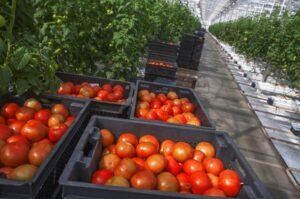
There are certain losses in quality and quantity between harvest and consumption which occur due to immaturity, over ripening, mechanical damage, and decaying of the plants. Also there are other losses due to poor harvesting, rough handling, improper packaging, and poor transport conditions. These losses should be minimized so as to increase the potential income from the production of the crops as lots of labour, land, energy, water, fertilizer, etc also gets wasted. Hence, every effort should be made to prevent these losses.
Post harvest handling of tomatoes is very important and should be paid attention to satisfy the buyer’s needs as the lifestyle and tastes of customers are changing day by day and they are demanding super quality tomatoes.
Cost Economics of Tomato:
| Economics of Crop cultivation under Micro Irrigation (1 Ha) | ||||||
| A | Variable Cost | Operations | Qty | Rate | Unit | Amount |
| 1 | Primary tillage operations | Tractor / Rotavator | 4 | 1000 | Hrs | 4000 |
| 2 | Seed & seedling preparations | Seed Tray + Seed + Vermi Compost + cocopit | 1 | 4500 | Set | 4500 |
| 3 | Weeding | 10 | 300 | Mandays | 3000 | |
| 4 | FYM / Compost | Composting | 10 | 2500 | Trolly | 25000 |
| 5 | Liquid Fertilizer | Fertigation | 1 | 15000 | Set | 15000 |
| 6 | Conventional Fertilizer | DAP + Urea + Potash | 1 | 3500 | Set | 3500 |
| 7 | Insecticides, Pesticides & Spraying | 1 | 2500 | Set | 2500 | |
| 8 | Irrigation & Electricity | 1 | 4500 | Set | 4500 | |
| 9 | Lease Rent | 1 | 5000 | Ha | 5000 | |
| 10 | Staking | Bamboo | 1 | 4500 | 4500 | |
| 11 | Harvesting | Plucking | 30 | 300 | Mandays | 9000 |
| 12 | Miscellaneous | 1 | 3000 | Set | 3000 | |
| Total Variable cost | 83500 | |||||
| B | Fixed Cost | |||||
| Investment on MIS | 112500.00 | |||||
| a | Interest on MIS value @ 18% | 20250.00 | ||||
| b | Depreciation @ 10% | 11250.00 | ||||
| c | Maintenance @ 5% | 5625.00 | ||||
| Total Fixed Cost | 37125.00 | |||||
| Total Cost (A+B) | 120625.00 | |||||
| Description | Yield Kg | Rate (Rs/Kg) | Amount | |||
| Tomato | 45000 | 5 | 225000.00 | |||
| Total Expenditure | 120625.00 | |||||
| Net Income | 104375.00 | |||||
| Note: This is a tentative rate considered. | ||||||
Conclusion
Tomato is one of the most profitable crops in the agricultural business. It is possible to cultivate throughout the year. Farmers can use scientific techniques and proximity to large cities or towns to increase the profits from tomato farming. The production of around 750 – 800 quintals per hectare can be achieved through proper cultivation technique.


